|
CLICK BUTTON TO GO |
|
|
|
|
|
|
|
|
|
|
|
|
|
Videos |
|
|
|
|
|
|
|
|
|
|
|
|
|
T O P I C |
|
|
|
|
|
|
|
|
|
|
|
|
|
|
|
|
|
|
JewishWikipedia.info
See our new site:
Go to Raphael Schachter and Verdi’s Requiem
Defiant Requiem - The Documentary
ONLY REFUGEES IN CONCENTRATION CAMPS
KNOW HOW TERRIBLE THEIR LIFE WAS
Auschwitz - Playing for Time (1980) (Vanesssa Redgrave, TV Movie)
Playing For Time was based on Fénelon's experience as a female prisoner in the Auschwitz concentration camp, where she and a group of classical musicians were spared in return for performing music for their captors.
The film was also adapted as a play by Arthur Miller.
MUSIC AND THE HOLOCAUST
Music and the Holocaust
While there is a growing body of research on the subject of music during the Nazi period, the information provided on this site is focused specifically on the Holocaust, particularly the ghettos and camps of Nazi-occupied Europe. Those interested in pursuing other aspects of the subject are invited to consult the links below, including our extensive bibliography, discography, and filmography, for further reading and listening suggestions.
The musical and historical material in this collection offers a particularly useful resource for Holocaust education. While it is focused on music, the website has the potential to be used quite broadly across the teaching curriculum, in classes on music and music history as well as in subjects such as history, social studies, language arts or citizenship. The section for educators provides resources that have been created specifically for secondary school teachers. The new student guide introduces the main themes of the website, asks questions and gives students a chance to discuss the issues online. There are also resources for those interested in including music in their Holocaust commemoration events.
See also MUSIC BY NAZI DEATH CAMP PRISONERS
PLAYED FOR THE FIRST TIME
THE MUSICAL SOUNDTRACK
OF THE NAZI CONCENTRATION CAMPS
culturacolectiva Giovanni M
When Richard Wagner composed romantic operas such as The Flying Dutchman, Tristan and Isolde, or the epic The Ring of Nibelungen, he probably never imagined his works would be heard by thousands of men, women, and children condemned to horrible deaths, that his music would be heard in the gas chambers of Nazi concentration camps.
The German army was aware of the properties of music. Psychology and medicine had continuously proven its benefits, such as reducing heart rate and anxiety, lessen headaches, improve concentration, as well as helping with depression and stress.
The Nazis then decided to use such properties during one of the darkest moments of humanity. This might have also been one of the forms of scientific experimentation done on the prisoners. Few are aware of the fact that the objects of violence were not just firearms, tanks, and airplanes, but also musical instruments.
Every camp had their own orchestra or a capella group conformed by 120 musicians working for the Nazis. These orchestras had the task of welcoming the prisoners to the sound of Strauss, Franzs, Lehar, or ballads of the thirties.
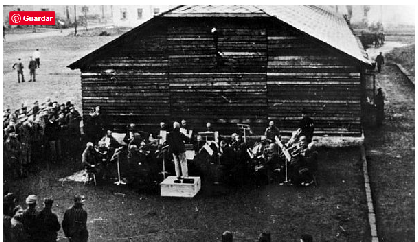
Nazi concentration camp music orchestra
After leaving the work camp, or attending to whatever the German officers would have prisoners do, the music needed to be a military march or the Nazi anthem.
According to writer and researcher Pascal Quignard, music was not used as a solace for the prisoners. “German soldiers did not put music in the death camps as a way to ease the pain or console the victims.” The author of The Hatred of Music claims it was made to create obedience.
Simon Laks was detained in Paris in 1941. He was a musician who had studied at the Warsaw Conservatory prior to arriving to Auschwitz. His talent led him to be a violinist in the camp orchestra and eventually the scribe and director. Laks would frequently play Schubert, Wagner, and Brahms. Eventually the prisoners retaliated with the song Die Gedanken Sind Frei (thoughts are free), symbolic of the 1848 revolution.
Doctoral candidate Melissa Kage, from Stanford University’s German Studies Department, believes this clash of melodies proves the Jewish prisoners knew the music was another form of oppression.
Kage claims, "The prisoners wished to die in peace, which is to say, they wanted the barest hint of autonomy over the space in which they die. But the melodies of Bach, Beethoven and Horst Wessel, along with jazz songs, wrested every last bit of space away from them."
In a final effort to make the detainees see this music as a form of relief, the German army invited mezzo-soprano Hedda Grab-Kernmayer to Theresienstadt Camp to sing repertoire of classic and popular composers. This happened on December 17, 1941. Her career came to an end shortly after this concert.
It seems that there are endless horror tales of the Nazi genocide. As time goes by, we only find out more of what truly went on inside the death camps. Thankfully there are people like Kage and Quignard who have made research into these topics most of us would be unwilling to touch.
MUSIC OF THE HOLOCAUST
UNITED STATES HOLOCAUST MEMORIAL MUSEUM
United States Holocaust Memorial Museum
(Click link for songs)
Music was heard in many ghettos, concentration camps, and partisan outposts of Nazi-controlled Europe. While popular songs dating from before the war remained attractive as escapist fare, the ghetto, camp, and partisan settings also gave rise to a repertoire of new works. These included topical songs inspired by the latest gossip and news, and songs of personal expression that often concerned the loss of family and home.
Classical music—instrumental works, art songs, opera—was also produced and performed during this period, notably by prisoners at the Theresienstadt (Terezín) ghetto and transit camp in Czechoslovakia, as well as in several other ghettos and camps.
or many victims of Nazi brutality, music was an important means of preserving and asserting their humanity. Such music—particularly the topical songs—also serves as a form of historical documentation. Like “audio snapshots,” these works offer a telling glimpse into the events and emotions that their creators and original audiences experienced firsthand.
MUSIC AND THE HOLOCAUST
THE CONCENTRATION AND DEATH CAMPS
Music and the Holocaust, Guido Fackler
Over the past three decades, the public has started to become aware of music-making in Nazi concentration camps. This is primarily due to contemporary performances of ghetto and Konzentrationslagern (KZ, or concentration camp) songs and of compositions from Theresienstadt, such as the 1975 premiere performance of Viktor Ullmann’s opera Der Kaiser von Atlantis oder der Tod Dankt Ab (The Emperor from Atlantis or Death Abdicates) in Amsterdam. It is also owing to the memoirs of musician survivors, as well as to films such as Daniel Monn’s Playing for Time (1980) and Roman Polanski’s The Pianist (2002). It is little known, however, that music of all types, styles and genres formed a fundamental component of life in the concentration camps, including the death camps. This begs the questions of how music could be created at all under these circumstances and what functions and meanings music served in the camps.
MUSIC ON COMMAND
From the time the first concentration camps were established in 1933, camp guards routinely ordered detainees to sing while marching or exercising or during punishment actions. This was done to mock, humiliate and discipline the prisoners. As Eberhard Schmidt experienced in Sachsenhausen, inmates who disobeyed the rules or who incorrectly carried them out ('In even steps! March! Sing!') gave the SS an excuse for arbitrary beatings:
Those who didn’t know the song were beaten. Those who sang too softly were beaten. Those who sang too loudly were beaten. The SS men inflicted savage beatings.
Mostly the prisoners were forced to perform Nazi group and soldiers’ songs, as well as SS folk songs and marches. In addition, they had to sing songs of symbolic value to individual detainee groups in order to humiliate them. For example, communists and social democrats were ordered to sing labour movement songs; those who were religious were ordered to sing religious songs relating to their denomination.
Music from radio broadcasts or record players was played over loudspeakers installed in some camps. In addition to propaganda speeches, military marches and 'German' music, in 1933-1934 the guards at Dachau played Richard Wagner’s music in order to 're-educate' political opponents. At Buchenwald, established in 1937, loudspeakers broadcast nightly concerts from German radio, depriving prisoners of sleep. Additionally, march music was played to drown out the sounds of executions.
At the camp command’s direction, musical ensembles were formed of imprisoned professional and amateur musicians. Prisoner choirs were prevalent particularly during the early years of the camp system, while after the war’s outbreak, inmate bands shaped the musical life of the larger concentration camps. The first of these official camp orchestras already existed in 1933, for example in the early concentration camps of Duerrgoy, Oranienburg, Sonnenburg and probably also in Hohnstein. After the reorganization of the camp system– when the first generation of concentration camps was dissolved (with the exception of Dachau) and after 1936 replaced by new, larger ones– there were prisoner orchestras (still before the war) in Sachsenhausen (as a continuation of the band at Esterwegen), Buchenwald and Dachau. With the expansion of the camp system and the founding of a satellite system of subcamps, official orchestras existed in almost all of the main concentration camps, larger subcamps and in some death camps. Sometimes there were several ensembles in one place, such as in Auschwitz, among them a brass band comprising 120 musicians and a symphony orchestra with 80 musicians. Their repertoire included marches, camp anthems, salon music, easy-listening and dance music, popular songs, film and operetta melodies, opera excerpts, and classical music such as Beethoven’s Fifth Symphony. On various occasions new compositions and original arrangements were created, such as, in Auschwitz, Mieczyslaw Krzynski and Henryk Krol’s 'Arbeitslagermarsch' (Concentration camp labour march). And while, according to Benedikt Kautsky, German military marches were prohibited, 'one was not nitpicky in the Buchenwald KZ, Auschwitz, where you could hear several old Prussian formal marches.'
The repertoire of the official camp orchestras depended on the preferences of the SS, on their musical sophistication, and on the occasions when the ensembles would perform. Inmate bands performed not only Sunday concerts for culturally-minded SS officers, but also – with the officers’ approval – for fellow inmates. During camp inspections, proud commanders showed off the ensembles as 'special attractions' and as proof of 'their' camp’s exemplary performance. The musicians’ main duties, however, were to provide background music for incoming and outgoing work commandos at the camp gates, and to perform music to accompany executions that were staged, as a deterrent, before the entire camp population. In the death camps, particularly Birkenau, the prisoner orchestras performed under the most inhuman of circumstances,something that caused some surviving musicians to experience feelings of guilt and depression for the rest of their lives. Some bands had to play in connection with the so-called selection process: this was supposed to deceive the newly-arriving prisoners into thinking that they did not face immediate death. A few orchestra members even had to play near the crematorium at the command of the SS. It remains clear, however, that the arrival of new transports, the selections, or the walk into the gas chamber, were not as a matter of principle accompanied by music, but only occasionally.
Finally camp bands and other inmate musicians were summoned to play for the guards’ private entertainment. On the one hand, the musicians were granted a special status that offered them some protection against arbitrary acts, as well as privileges essential for survival: 'milder' work assignments, better clothing or additional food rations. In this sense, making music served as a survival strategy. On the other hand, the closeness between the musicians and the perpetrators led to self-accusations, to the envy of fellow inmates and to a dangerously dependent relationship with the SS.
MUSIC INITIATED BY THE PRISONERS
In contrast to the previously mentioned examples of forced music-making, the detainees also played and composed music on their own initiative, for themselves and their fellow inmates.Here, music served as a cultural survival technique and as a means of psychological resistance: it helped overcome the life-threatening situation at the camp andassisted inalleviating the terror. Simple humming or whistling could combat fear and loneliness in solitary confinement. Music helped inmates retain their identity and traditions, counteracting the SS’s destructive intention, which was directed not only towards the prisoners’ physical existence, but also towards their culture.
Prisoners played music for themselves even in the early concentration camps. However, there were only a few instrumental groups at that time. Group, solo and unaccompanied singing of various songs the inmates brought into the camps was predominant. The first Lagerlieder (camp songs) and KZ-Hymnen (concentration camp anthems), like the well-known 'Moorsoldatenlied' (Song of the Peat Bog Soldiers), were written by the inmates. These songs could be sung at any time and required little practice or preparation. Group singing sessions produced a sense of companionship and belonging. In the initial phases of the camp system, the dominant styles were amateur music from the youth and blue-collar movements, because most of the prisoners at that time were political opponents of the Nazis. During these initial years, professional musicians were the exception. Starting in 1939, after the beginning ofWorld War II, the level of musical skills and diversity expanded. From that point on, more and more prisoners from various countries and social classes were deported to the camps, among them a higher percentage of professional musicians, artists and intellects. The increase in the number of prisoners also expanded the scope of musical events, and the different national traditions reflected by the inmates began to enhance musical life at the camps.
Musical activities were at their most widespread from 1942-43 onwards. During this period, prison labour was used in the arms industry, and on 15 May 1943 the SS granted a Prämiensystem (bonus system). At the same time, the concentration camp system expanded with the building of satellite camps. In connection with the Prämiensystem this brought the prisoners certain 'privileges' from the SS. These concessions, of course, were designed primarily to increase the work output and to forestall disturbances – and in any case affected predominantly German inmates, prisoner functionaries and 'prominents'. However, as a result of such concessions, it became easier to procure instruments and sheet music from outside, create camp songs or other compositions, set up a few musical groups, give concerts and organize such other cultural events as theatre or cabaret performances.
Contrary to widespread opinion, these activities were illegal only in some instances, not all. When the music was linked to political or other forbidden content, it was illegal: in these instances one could only play secretly and under fear of discovery. For instance, on 7 November1933 at Börgemoor, inmates secretlycommemorated the 16th anniversary of the October Revolution. Larger musical events (block or camp performances) could only be organized with the approval of the camp director and the support of functionaries. One of the first camp performances was organized by the prisoners on 27 August 1933 at Börgermoor. 'Circus Konzentrazani', planned by the actor Wolfgang Langhoff, was produced in reaction to nightly beatings by the SS. This event encompassed music, humour and artistry as a means of 'general encouragement' to the inmates. The camp guards were also amused by this form of entertainment. During that event the 'Moorsoldatenlied' received its debut performance. In some campssuch events were held regularly. At a block in Buchenwald where a cinema had been installed, between August 1943 and December 1944, a total of 27 so-called 'concerts' were held, comprising exhibits, sketches and artistic performances, as well as cabaret and theatre excerpts performed by various inmate groups. As long as 'normal' camp operations were not affected, other musical activities were either implicitly tolerated by the SS or took place in a semi-legal way.
Within the limited freedom granted by the camp guards and the functionaries, prisoners assembled a wide array of musical shows. Music could only be made during restricted 'leisure time': that is, after the evening roll-call or on Sundays, which were mostly labour-free. At the main camp in Auschwitz, for example, there were music activities by two vocal quartets and a smaller vocal group, as well as by three choirs. Music was also played by instrumentalists. This occurred in an inhumane atmosphere, unsympathetic to artistic activity and marked by constant hunger, psychological and physical abuse, illness, epidemics, terror and the fear of death. In contrast to music-making on command, which the inmates had to do almost daily, musical activities carried out on the prisoners’ own initiative formed a highlight of camp life. However, the larger the social differences between the prisoner groups in a camp, the more music played a role in separating the privileged prisoners (i.e. prisoner functionaries,'prominent' detainees and their closest entourage) from the less privileged. Then most inmates struggled for sheer survival.
CONCLUSION
Musical life in the concentration and death camps was of a distinctly two-faced nature. On the one hand, music acted as a means of survival for the inmates; on the other hand, it served as an instrument of terror for the SS. Prison personnel abused inmate musicians for their own purposes. With forced daily musical performances they furthered the process of breaking the prisoners’ willpower and of human degradation. Thus, music in Nazi camps served as a necessary distraction and method of cultural survival for the victims, and simultaneously as a means of domination for the perpetrators.
THE HOLOCAUST - LEST WE FORGET - ORCHESTRAS
The Holocaust - Lest we Forget
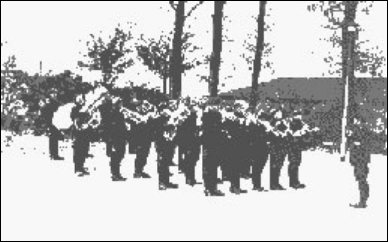
The question why the Nazis used orchestras in concentration and extermination camps, and why the life of some musicians was spared and others not is difficult to answer. Some Nazis realized the advantage of having music dupe the unsuspecting and weary prisoners on arrival or when sending them on their way to the gas chambers. Then there were those in the Nazi hierarchy who believed that music would enhance their own entertainment. For instance, when victims were cruelly treated during long roll-calls on parade grounds, counting prisoners in marching columns to and from work detail, or during executions. However, the most logical answer still seems to be that many of the cruel Nazi hangman officials had a taste for good music. One such example was the sadistic SS Oberaufseherin - SS Chief Overseer, Maria Mandel. She was Chief of all the female Nazi Wardens in Birkenau. Since 1942 she held the position of Schutzhaftlagerführerin - Chief Warden for the women's barracks. As a lover of classical music she was an encouragement to and protector of the musicians who played in the women's orchestra of Birkenau. These female prisoner musicians were treated better than other inmates, such as those who were incarcerated in the political section or those who were employed in the kitchen. Their barracks were kept tidy and they usually received sufficient food and of better quality than the other inmates.
However, much was demanded of these musicians. They had to perform for hours at roll-call regardless of weather conditions. After roll-call the other inmates, who were assigned to slave labor detail, marched out to work to the beat of music. Then in the evening, when these work details returned totally exhausted, they were again welcomed by the musicians as they marched back to their barracks. Again to the beat of music in order to be counted. Music was ordered for all official events such as the announcing of a speech by the Lagerführer - commandant. Or, to meet the daily incoming transports delivering its cargo of human flesh to the camps. Jews arriving at these camps to be killed were given the impression that their "new home" was not all that bad. The orchestras had to play when new arrivals, selected to be gassed, were sent directly to the gas chambers. They also had to play during the dreaded Selectionen - selections when the less healthy and sick were separated from the healthier ones who were still capable to work yet another day. And they had to play when executions were ordered such as the hanging of prisoners who had attempted escape. Last but not least, they had to perform to satisfy the pleasures of their tormentors, the men and women of the SS.
Hans Bonarewitz, the prisoner escaped from camp Mauthausen, is brought "in Nazi circus style" to the gallows on a makeshift cart pulled by fellow inmates; The camp orchestra had to continuously play the song J'attendrai ton retour - I shall wait for your return. Another song, the traditional German children's song "Alle Vögel sind schon da - All the birds are back again," was played immediately before execution. Information supplied by Mr. Aitor Fernandádez-Pacheco, Paris, maker of the documentary film "Mauthausen, una mirada Española," who interviewed the former Spanish prisoner Mario Constante for his documentary.
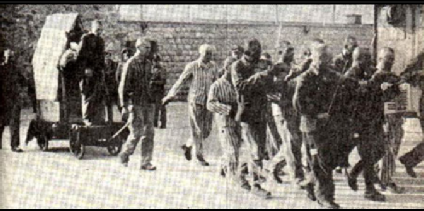
Hans Bonarewitz, the prisoner escaped from camp Mauthausen, is brought "in Nazi circus style" to the gallows on a makeshift cart pulled by fellow inmates; The camp orchestra had to continuously play the song J'attendrai ton retour - I shall wait for your return. Another song, the traditional German children's song "Alle Vögel sind schon da - All the birds are back again," was played immediately before execution. Information supplied by Mr. Aitor Fernandádez-Pacheco, Paris, maker of the documentary film "Mauthausen, una mirada Española," who interviewed the former Spanish prisoner Mario Constante for his documentary.
Authoress Krystyna Henke who interviewed Louis Bannet, the trumpeter of Birkenau, writes in her report: "Unusual as it may seem, and contradictory for an environment whose function was to eradicate lower forms of human life, as defined by the Nazis, including all forms of their cultural expression, music was indeed played in many, though not all, camps. There is an important body of literature, based primarily on survivor testimonies, that illustrates musical life in the camps. There is, for example, 'The Terezin Requiem' by Josef Bor, or 'Music in Terezin 1941-1945' by Joza Karas, both of which describe the rich musical life in Theresienstadt, a ghetto that through subterfuge and propaganda was held up as a model camp by the Nazis in order to successfully assuage any doubts the Red Cross or other visiting international authorities may have had regarding the humanitarian treatment of prisoners."
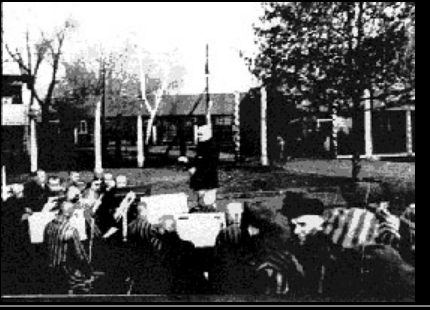
Prisoners' orchestra entertaining the SS in Auschwitz I
In five of the extermination camps, the Nazis created orchestras using prisoner-musicians, forcing them to play while their fellow prisoners marched to the gas chambers. The suicide rate among musicians was higher than that of most other camp workers with the exception of the Sondercommandos - death details. Many musicians were forced to watch helplessly as friends, family and fellow Jews systematically were destroyed. Auschwitz/Birkenau alone featured six different orchestras, one of which contained no less than 100-120 musicians.
Fania Fenelon describes her experience as a member of a women's orchestra in Birkenau from January 1944 to liberation in her book 'Playing for Time.' Fenelon states in her book that even though she had clean clothes, daily showers, and a reasonable food supply she had to play light-hearted, cheerful music as well as marching music for hours on end while her eyes witnessed the marching of thousands of people to the gas chambers and crematoria."
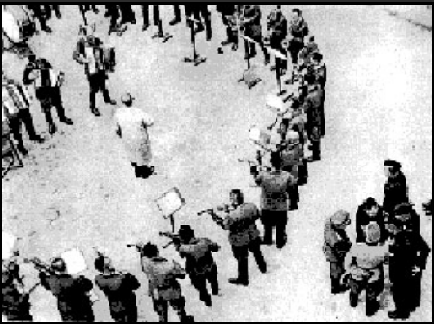
The orchestra of the Janowska Camp in Lvov, Poland in 1943
Other rich memoirs in which music was at the foreground in Nazi camps include 'Music of Another World' by Szymon Laks, 'Het meisje met de accordeon: De overleving van Flora Schrijver in Auschwitz/Birkenau en Bergen Belsen - The girl with the accordion: The survival of Flora Schrijver in Auschwitz/Birkenau and Bergen Belsen' by Mirjam Verheijen, 'Trompettist in Auschwitz I: Herinneringen van Lex van Weren - Trumpeter in Auschwitz I: Memories of Lex van Weren' by the author Dick Walda and 'Louis Bannet: Virtuoso of Birkenau' by Krystyna Henke. These five sources concentrate on the musical activities within Auschwitz or more correctly its extension, Birkenau.
Many excellent musicians never were chosen to play. They were either not recognized or the Nazis already had enough musicians for their respective orchestras. For anyone who entered one of Hitler's horror camps, survival was foremost on the minds of the hapless inmates. Survival by means of playing a musical instrument was one such way. However, for all survival attempts a price had to be paid. These musicians literally played to stay alive, a day at a time because one just never knew what mood an SS guard might be in. On the other hand, by playing their instruments they sent hundreds of thousands of their fellow Jews to their death and there was nothing they could do to prevent it. Although the musicians more than likely did not see it that way, after all survival was the main object, nevertheless their function as musicians in an orchestra or otherwise much looked like the roll the Pied Piper of Hamelin played. He was the legendary 13th-century figure who rid Hamelin, Germany, of its rats by charming them away with his flute playing. When he was refused payment, he charmed away the town's children in revenge.
SURVIVING THE HOLOCAUST THROUGH MUSIC
Thirteen 2017
Through intimate interviews and live performances, They Played for Their Lives artfully portrays how music saved the lives of young musicians. Playing music in the ghettos and concentration camps not only fostered spiritual strength within themselves and others, but often proved a bargaining tool that spared their lives. The documentary follows the personal narratives of eight survivors.
Chaim recounts how he saved his father from beatings, by teaching an SS officer to play the harmonica. Anita, who played cello in the Women’s Orchestra in Auschwitz, was spared inhumane forced labor. And little Hellmuth whistled with the band in exchange for extra food and clothing. Each of these unique stories illustrate the power of music to sustain the human soul.
At the end of World War II their lives unfold in surprising ways, yet music remains at the core of their memory and legacy. Charcoal illustrations by Ari Binus, a live piano performance by
106-year-old Alice, and a moving reunion of two boys who searched for each other for 66 years, make this compelling viewing.
LEARN MORE
Dr. Nurit Jugend, director of They Played for Their Lives, created this They Played for Their Lives Discussion Guide for educators to use for post-screening discussions. Appropriate for all viewers, the guide features a director’s note and addresses what music meant at concentration camps —- both to the Nazis and to prisoners. More information about the documentary is found on the official film site, They Played for Their Lives.
THE LANGUAGE OF MUSIC
Essay by Nurit Jugend, Filmmaker, Composer and Music Educator
During WWII, under the ruling of Nazi Germany, European Jews were being persecuted and forced to live in inhumane conditions. In the ghettos and concentration camps, they lived with constant hunger, sickness and fear of death. However, even under these horrific circumstances, there were those who managed to play music or compose a new song.
Music is a universal language that has the power to express what cannot be told or explained in words. The music that was either composed or performed during the Holocaust, provided people with a semblance of emotional comfort and distraction from their horrific reality: “music gave us so much, to escape even for a few moments to a ‘normal’ world” explains Greta, a survivor from ghetto Terezin. Though they could not escape from their physical reality “music allowed us a complete disconnect and emotional escape from the daily life”.
Above all, music had the power to save people’s lives. The Nazis highly valued music and often gave special treatment to those who had the skill to play an instrument. This appreciation to music allowed some musicians to get better jobs, better living conditions, more food and clothing. In numerous ghettos and camps, people who played an instrument were selected to join the local band or orchestra. Some musicians were forced to entertain the Nazis during holidays and parties. The travesty of musicians who were forced to play in the concentration camps would haunt them forever. In many cases, they played as they watched their family and friends march into the gas chambers. The ‘useful’ skill of those musicians was undoubtedly a horrific and traumatic experience, but one that often saved their lives: “the cello really saved my life because to be in this orchestra was a way of survival, because as long as they wanted music they would be foolish to put us in the gas chambers” explains Anita, a survivor from Auschwitz.
Therefore, for these survivors, their children and grandchildren, music has further meaning. In these families, the legacy of playing an instrument or composing music takes on another dimension. It is the legacy of ‘music and song from the Holocaust’ that carries the proof of victory; the power of human survival to continue living and overcome trauma and genocide, and the power of music to exist beyond any act of evil: “They tore off our belongings, food and clothing but music is the one thing that they could not take away from us, music that evil could not destroy” states Alice, a survivor from Terezin.
Music is a universal language that speaks to all mankind regardless of ones faith or religion. I feel it is my moral obligation to preserve the legacy of ‘music from the Holocaust’ and pass it on to the following generations so that the victims will not be forgotten. The film’s mission is to educate future generations about the Holocaust and strive for more tolerance and acceptance among people worldwide.
Music in Concentration Camps 1933–1945, Guido Fackler, Music and Politics
Official Camp Orchestras in Auschwitz
Terezín: 'The music connected us to the lives we had lost' Guardian Music April 2013
Ed Vulliamy talks to Anka Bergman, 96, her daughter, Eva Clarke, who was born in a Nazi camp, and other survivors about life in Terezín, the camp where a wealth of imprisoned Czech musical talent suffered and played
Music of the Holocaust: Highlights from the Collection United States Holocaust Memorial Museum
Choral Music in Theresienstadt, 1941-1944, Nick Strimple, The Orel Foundation
THE RETURN OF THE VIOLIN
IPO FUND 2018 (1.04.15)
Czestochwa, Poland,
where 40,000 Jews were killed by the Nazis.
Sigmund Rolat tells the story of
a Stradivarius violin belonging to
the great Bromislow Huberman.
It is a story that connects
the great violinist Joshua Bell, Huberman,
the Nazi Reinhard Heydrich,
the creation of the Israel Symphony Orchestra, Toscanini and a Conneticut jail.

The Nazi accession to power affected musicians from every corner of German society. Numerous well-known composers, conductors, musicologists, instrumentalists, and singers were affected by the Party’s
increasingly repressive actions and legislation
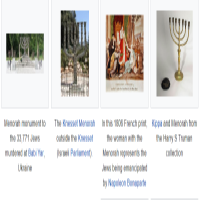
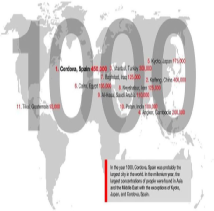
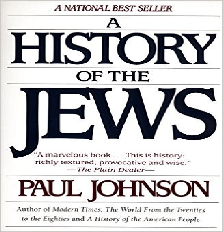
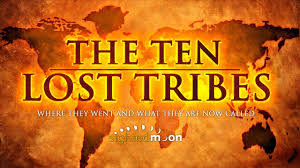
Musical works of diverse origin and style were performed and composed during the Nazi period.
The Nazi Party itself made widespread use of music
at rallies and public events,
particularly marching music and rousing propaganda songs.
In the Nazi imagination, music had a unique significance and power to seduce and sway the masses.
The Party made widespread use of music in its publicity,
and music featured prominently at rallies
and other public events.
The Horst Wessellied (Horst Wessel song)
was popular and widely sung.
Many propaganda songs were aimed at the youth.
The Hitlerjugend (Hitler Youth)
developed an elaborate music program
While for the vast majority of Nazi inmates armed resistance was almost impossible, isolated groups were able to engage in organised resistance—and music often supported their cause.
Amongst Jewish victims, the partisans that fought in the forests of Eastern Europe are one prominent example.

The Nazi ghettos and camps housed millions of people from across Europe. Their responses to internment were as diverse as the religions, ages, and nationalities
they represented.
For Jewish victims, music was a valuable medium of expression and an integral part of daily life in the ghettos.

Music has played an integral role in Holocaust commemoration since the immediate post-war period.
In the late 1940s, Jewish Holocaust survivors established a lively and diverse musical life in Displaced Persons’ camps
in Allied-occupied Europe, particularly in the
American zone of occupied Germany.
Among the new songs that they created were many recounting the horrors of the war years, chronicling mourning and loss, and lamenting the challenges of displacement. Music also formed an integral part of early Holocaust commemoration ceremonies among survivors.
LOST MUSIC FROM CONCENTRATION CAMPS
PERFORMED FOR FIRST TIME
i24NEWS 2018 (6.21)
TRENDING | A lost composition written in the concentration camp was performed in Israel. Our Daniel Campos interviewed a survivor who witnessed
the composer creating the masterpiece.
HOLOCAUST CAMP MUSIC
GETS PERFORMANCE
FlimoraGo -One 2018 (3.00)
Music by Nazi death camp prisoners played for first time
Pieces of music composed by prisoners in Nazi concentration camps have been played to an audience
for the first time.
They were collected over decades by an Italian composer and performed at a concert in Israel.
MUSIC IN CONCENTRATION CAMPS:
THE PROCESS OF REPLAYING SONGS
FROM THE HOLOCAUST
ROME REPORTS IN ENGLISH, 2011 (2.32)
CHAINED MELODY: A VIOLIN “RECITAL”
IN AUSCHWITZ
AishVideo 2017
A moving depiction of a true event that occurred one evening in the concentration camp. By A.R. Miller
Comment Eric Trumpler 11 months ago
This is a beautiful story, but why do you accompany it with the wrong music? I had to turn off the sound, because i found the piano music so annoying, even that there was music playing when the story suggested that there was silence....this is the music that should be on this video, and not at the beginning, but at the right point in the story: https://www.youtube.com/watch?v=eYdXu2MH6YE
MUSIC AND THE HOLOCAUST
GHETTOS AND CAMPS

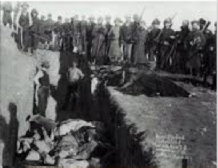
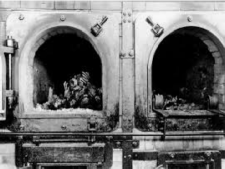
THE
INCREDIBLE
STORY OF THE JEWISH PEOPLE
|
|
I SURVIVED WITH MUSIC':
FOUNDER OF
HOLOCAUST SURVIVOR BANDCBS Miami, 2017 ~
Saul Drier is using music to spread
a message of peace all over the world.
